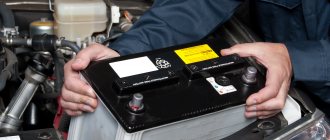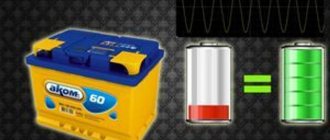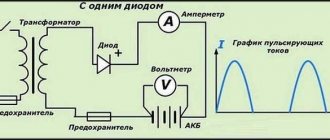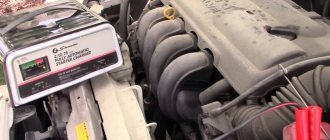- home
- car battery
- …
In winter, topics related to car batteries are especially relevant (after all, a cold start can quickly discharge it). Many people change old batteries ( simply handing them over to buyers ), buy new ones (the main thing is to choose the correct polarity ) - however, most try to recharge them and use them further. Fortunately, modern batteries last quite a long time (about 4 - 5 years), but this period can be much reduced! If you apply the current incorrectly and calculate the charging time incorrectly, the battery can quickly fail. Therefore, today we have detailed information about how long it takes to charge your battery...
I would like to immediately make a reservation - we will charge the car battery at home with a special charger, at an approximate temperature of 25 degrees Celsius, this is important, because if the temperature exceeds 35 degrees, then it is better not to start the process (here is the dependence of the temperature of the electrolyte and the surrounding air)! The thing is that the electrolyte has different densities at different temperatures (by the way, you can see how much of it is in different batteries ). However, I suggest remembering the principles of charge and discharge.
Battery operating principle
In order to charge it, you need to understand how it works - no, I won’t break it down into its various components now, everyone already knows that inside there are lead plates in a special solution of sulfuric acid . We need to understand what, for example, 55 Ampere hour and 12 Volts are.
So:
- Amps and Hours – Battery capacity is measured in Ampere*hours. That is, if your battery (rechargeable battery) is 60 Ah, then it can deliver 60 Amperes for one hour. Accordingly, if the load drops, for example to 30A, then it can supply for two hours and so on. I think this is understandable.
- Voltage - it is generally accepted that the voltage is 12 Volts, although this is not entirely correct. The normal value of the working version is 12.6 - 12.7V (there are options with more), this is a fully charged 100% version.
If the voltage is 12V, then we can state that the battery discharge is approximately 40 - 50%, but with such indicators you can drive. If your car is in good working order and the generator provides normal “charging”, then the voltage will quickly be restored. I would also like to note that an indicator of 11.5 - 11.6V indicates a “ deep discharge ”, this is very “unpleasant” for the battery. “sulfation” of the lead plates inside begins , which simply reduces the capacity of the battery - maybe so much that the car simply won’t start.
That is, we understand that the normal readings are 12.7V (charged), it is with this voltage that 60 Amperes will be delivered for an hour, and then it will drop to 11.6V (discharged). Then charge and re-use.
How to prepare the battery for charging
Wherever the car battery is charged, the main thing is that the room for this is as safe as possible.
When the battery begins to charge, it begins to release toxic chemical fumes. Therefore, the room should be well ventilated and ventilated. Also, you should not charge the battery where there may be problems with electrical wiring in the form of periodic power surges and power outages. Of course, any operation with a battery is carried out where there are no open sources of fire or flammable substances. It is necessary to charge the car battery by first cleaning it from dirt and dust, and also completely discharging it before charging.
Quickly discharging the battery is easily done using a load in the form of light bulbs. One or two are connected to the terminals, and then you have to wait until they go out.
Regardless of how long it takes to charge a car battery, during the entire charging process all possible holes in the battery should be left open, unscrewing the caps and plugs so that the plastic case does not swell and rupture due to the large accumulation of gases inside.
Two battery structures
This is also an important line, the whole point is that you need to charge each type differently, or rather prepare for the charging process. SO:
The first type is the so-called maintenance-free batteries. They have an electrolyte inside and it is, as it were, “sealed” inside, that is, it cannot evaporate. If it turns into steam, it then condenses on the walls and re-precipitates into the main electrolyte. This is the most problem-free type. No need to worry about level replenishment, density, etc.
The second type - (which is becoming a thing of the past) - serviced. It does not have a sealed housing, so the electrolyte (or rather the water from it) can evaporate, thereby lowering the level. This option is one of the most problematic; you need to know how to care for it and charge it! For example, if the level is low, charging should not occur! Proper preparation is needed.
We'll talk about that next.
Battery charging principle
How many hours should a 60 or 55 Ah device charge, why does it take so long to charge? If you're wondering how long it can take to complete this task, let's understand the charging concept. A charger for 60, 55, 70 or another number of Ah is a direct current unit that produces 14.4 volts at the output. This is the amount of voltage used for full charging.
If a 60 Ah device is recharged, its resistance indicator increases, and the current parameter, on the contrary, decreases. When the voltage on the device increases to 12 V and the current drops to 0, we can assume that the charging process is complete (the author of the video is the Battery Manager channel).
Battery preparation
Before charging the battery, you need to properly prepare it, because if you remove it, you need to check everything at once. As I wrote above, we will talk specifically about the battery being serviced.
- First you need to remove all condensation, oxide and dirt from the surface and contacts. To do this, simply take an ordinary rag, soak it in a solution of ordinary soda and wipe the upper part - the contacts. This way we achieve cleanliness - this is important! After all, if your battery has screw-on caps on top, then dirt may get into them during dismantling - which is highly undesirable! After all, it can cause battery failure by simply bridging the banks .
- You can unscrew the covers. We check the electrolyte level, if it is extremely low - it does not cover the plates, then it is MANDATORY to add distilled water. Otherwise, you will simply “kill” your battery. The lead plates will heat up and crumble.
- Ideally, you need to measure the density of the electrolyte. Let me remind you that for a working, normal battery it is 1.26 – 1.30 g/cm3.
After the preparatory work, you can proceed to charging. However, it is worth noting that it comes in two options - using direct current and using constant voltage, the time can vary greatly from these parameters. Unless, of course, you have a universal charger, you have minimal settings there.
DC charging time
I think there is no need to explain that you connect the negative terminal of the battery to the negative terminal of the “charger” with the positive terminal in exactly the same way. Many people adhere to this option, because the “Amperage” that we supply to the battery is a very important parameter - it should never be exceeded, and if it is greatly underestimated, the battery will take a long time to charge.
I would also like to warn you that the voltage must be higher than the nominal voltage - that is, from the charger we get about 13.8 - 14V, about the same as a car generator gives. Only then will the charge begin; if the voltage is less than 12 (and even more so 11V), then nothing will happen, but will most likely worsen the discharge.
SO : The optimal voltage is considered to be 10% of the total battery capacity, that is, if you have 75 Ah, then you need to charge with a current of 7.5A.
Thus - if your battery is completely discharged (voltage less than 11.7V), then it should charge in 10 hours! However, the time may be reduced depending on the discharge level.
In the version with a serviceable battery, this is quite easy to determine - as soon as bubbles appear from the surface of the electrolyte in the banks, this means that the charge has been fully completed.
I would like to add on my own behalf - in ancient times (about 20 years ago), my father very often charged the battery at home, especially in winter. He set the 60Ah option to a current of 2A and left it overnight, so the battery took the required amount of energy from this small current. It should be noted that the discharge was not deep then. Therefore, if you just want to “feed” your battery, for example, the voltage at the contacts is exactly 12V, set it to a current of 1 - 2A overnight!
However, now there is another method that also requires a minimum of human intervention.
How to do it right
To the question of how long it takes to charge a car battery, you can give an exact answer: on average, this process lasts 10 hours, no less
. Experienced motorists recommend increasing the charging time with low currents to 15 hours in order to “pump” the battery properly. Of course, this is quite a long time. But only this charging time ensures full and high-quality battery operation. By the way, to ensure that the time does not drag on for the car owner for too long, you can leave the battery to charge overnight, having previously adjusted all the necessary indicators.
To do everything as correctly as possible, without consequences, it is best to disconnect the wires from the battery and completely remove it from the hood of the car
(keeping the battery inside the car is allowed, but only as a last resort).
The charging process must not be interrupted
: this will negatively affect the battery capacity level. This is how to properly and safely charge a car battery.
Constant voltage charging time
This option is gaining increasing popularity - it is this principle that is implemented on many Chinese devices, where there are practically no “VOLTAGE” and “AMPERAGE” indicators, but only glowing “dots” or a scale that indicates the charge. This device is designed specifically for maintenance-free batteries, because you will not be able to watch the boiling of the electrolyte and the release of gas from it, because everything is sealed. Therefore, the first option is not entirely good. Here the voltage and amperage are automatically adjusted.
SO : The voltage can float in the range from 13.8 to 14.5V, the higher the voltage, the faster the charge.
So in the first hour the battery can absorb from 50 to 60% of the nominal capacity. That is, if it is 60A, then 60X60% = 36A
In the second hour - the voltage drops and the charge occurs more slowly, about 15 - 20%
The third hour is even lower, about 7 – 8%
The fourth is almost full capacity at 90 - 96%.
The subsequent hours are not really needed, the current strength can “drop” to 0.2A, charging to 100% will take almost the same 10 hours.
This option is convenient because you don’t need to worry about setting up the device – it will do everything for you.
DETAILED VIDEO - MUST WATCH!
So, how long does it take for batteries 55, 60, 75 - 100 Ah?
Guys, as you understand, everything is quite individual, which device you use. You also need to understand whether the discharge is complete or not.
If you exaggerate and imagine the complete discharge of any of the batteries. THAT:
In the case of a current of 10% of the nominal value - 10 hours until fully charged.
In the case of “regulated” voltage – 4 – 5 hours, up to 90 – 95% (which is quite enough) and again 8 – 10 hours until fully charged.
As you understand this, with a maximum discharge, if you have a partial discharge, then the time is much adjusted.
That's all, I think the information was useful to you. Read our AUTOBLOG.
Similar news
- Which terminal to remove from the battery. For long-term parking, for…
- Do I need to unscrew the battery caps when charging? And how is that …
- Differences between a traction battery and a starter battery. What is the main sec...











